COVID-19 CXR Classification: Applying Domain Extension Transfer Learning and Deep Learning
Abstract
1. Introduction
Background
2. Related Works
2.1. COVID-19 X-ray Image Classification Using Pretrained Models Based on Transfer Learning
2.2. Domain Extension Transfer Learning and Augmentations
3. Materials and Methods
3.1. Datasets
3.2. Preprocessing
Data Augmentation
3.3. Domain Extension Transfer Learning
Pretraining and Fine-Tuning
3.4. Classification Models
CNN Models for Image Classification
4. Results
4.1. Experimental Settings
4.2. Evaluation
4.3. Evaluation Results
4.4. Statistical Test
4.5. XAI
5. Discussion
6. Conclusions
- The proposed methodology has limitations in that it is applied within the scope of CXR. By additionally collecting CT and MRI medical images and applying them to the proposed model, we are planning an integrated multimodal study by securing patient information related to COVID-19 symptoms and the diagnostic information of medical staff.
- To prevent the increase in asymptomatic infections due to the spread of vaccines, we plan to expand the scope of the research by additionally collecting the biometric information of asymptomatic patients.
- In addition, the proposed methodology has limitations in the scope of research applied only to the COVID-19 dataset. In the future, we plan to collect various new lung disease data and apply them to the proposed model for testing.
Author Contributions
Funding
Institutional Review Board Statement
Informed Consent Statement
Data Availability Statement
Acknowledgments
Conflicts of Interest
References
- Zhu, N.; Zhang, D.; Wang, W.; Li, X.; Yang, B.; Song, J.; Zhao, X.; Huang, B.; Shi, W.; Lu, R.; et al. A novel coronavirus from patients with pneumonia in China, 2019. N. Engl. J. Med. 2020, 382, 727–733. [Google Scholar] [CrossRef] [PubMed]
- WorldOMeter. Coronavirus Live Statistics. Available online: https://www.worldometers.info/coronavirus/ (accessed on 5 October 2022).
- Misra, S.; Jeon, S.; Lee, S.; Managuli, R.; Jang, I.S.; Kim, C. Multi-Channel Transfer Learning of Chest X-ray Images for Screening of COVID-19. Electronics 2020, 9, 1388. [Google Scholar] [CrossRef]
- Asrani, P.; Eapen, M.S.; Chia, C.; Haug, G.; Weber, H.C.; Hassan, M.I.; Sohal, S.S. Diagnostic approaches in COVID-19: Clinical 404 updates. Expert Rev. Respir. Med. 2021, 15, 197–212. [Google Scholar] [CrossRef]
- Brenner, D.J.; Hall, E.J.; Phil, D. Computed Tomography-An Increasing Source of Radiation Exposure. N. Engl. J. Med. 2007, 357, 2277–2284. [Google Scholar] [CrossRef] [PubMed]
- Wu, G.; Li, X. Mobile X-rays are highly valuable for critically ill COVID patients. Eur. Radiol. 2020, 30, 5217–5219. [Google Scholar] [CrossRef]
- Akl, E.A.; Blazic, I.; Yaacoub, S.; Frija, G.; Chou, R.; Appiah, J.A.; Fatehi, M.; Flor, N.; Hitti, E.; Jafri, H.; et al. Use of Chest Imaging in the Diagnosis and Management of COVID-19: A WHO Rapid Advice Guide. Radiology 2021, 298, E63–E69. [Google Scholar] [CrossRef]
- Akter, S.; Shamrat, F.M.J.M.; Chakraborty, S.; Karim, A.; Azam, S. COVID-19 Detection Using Deep Learning Algorithm on Chest X-ray Images. Biology 2021, 10, 1174. [Google Scholar] [CrossRef]
- Gupta-Wright, A.; MacLeod, C.K.; Barrett, J.; Filson, S.A.; Corrah, T.; Parris, V.; Sandhu, G.; Harris, M.; Tennant, R.; Vaid, N.; et al. False-Negative RT-PCR for COVID-19 and a Diagnostic Risk Score: A Retrospective Cohort Study among Patients Admitted to Hospital. BMJ Open 2021, 11, e047110. [Google Scholar] [CrossRef] [PubMed]
- Okolo, G.I.; Katsigiannis, S.; Althobaiti, T.; Ramzan, N. On the Use of Deep Learning for Imaging-Based COVID-19 Detection Using Chest X-rays. Sensors 2021, 21, 5702. [Google Scholar] [CrossRef]
- Furtado, A.; Andrade, L.; Frias, D.; Maia, T.; Badaró, R.; Sperandio Nascimento, E.G. Deep Learning Applied to Chest Radiograph Classification—A COVID-19 Pneumonia Experience. Appl. Sci. 2022, 12, 3712. [Google Scholar] [CrossRef]
- Soda, P.; D’Amico, N.C.; Tessadori, J.; Valbusa, G.; Guarrasi, V.; Bortolotto, C.; Akbar, M.U.; Sicilia, R.; Cordelli, E.; Fazzini, D.; et al. AIforCOVID: Predicting the Clinical Outcomes in Patients with COVID-19 Applying AI to Chest-X-rays. An Italian Multicentre Study. Med. Image Anal. 2021, 74, 102216. [Google Scholar] [CrossRef]
- Badawi, A.; Elgazzar, K. Detecting Coronavirus from Chest X-rays Using Transfer Learning. COVID 2021, 1, 403–415. [Google Scholar] [CrossRef]
- Ramadhan, A.A.; Baykara, M. A Novel Approach to Detect COVID-19: Enhanced Deep Learning Models with Convolutional Neural Networks. Appl. Sci. 2022, 12, 9325. [Google Scholar] [CrossRef]
- Teixeira, L.O.; Pereira, R.M.; Bertolini, D.; Oliveira, L.S.; Nanni, L.; Cavalcanti, G.D.C.; Costa, Y.M.G. Impact of Lung Seg-mentation on the Diagnosis and Explanation of COVID-19 in Chest X-ray Images. Sensors 2021, 21, 7116. [Google Scholar] [CrossRef]
- Salvatore, C.; Interlenghi, M.; Monti, C.B.; Ippolito, D.; Capra, D.; Cozzi, A.; Schiaffino, S.; Polidori, A.; Gandola, D.; Alì, M.; et al. Artificial intelligence applied to chest X-ray for differential diagnosis of COVID-19 pneumonia. Diagnostics 2021, 11, 530. [Google Scholar] [CrossRef]
- Le Dinh, T.; Lee, S.H.; Kwon, S.G.; Kwon, K.R. COVID-19 Chest X-ray Classification and Severity Assessment Using Convolutional and Transformer Neural Networks. Appl. Sci. 2022, 12, 4861. [Google Scholar] [CrossRef]
- Guiot, J.; Vaidyanathan, A.; Deprez, L.; Zerka, F.; Danthine, D.; Frix, A.-N.; Thys, M.; Henket, M.; Canivet, G.; Mathieu, S.; et al. Development and validation of an automated radiomic CT signature for detecting COVID-19. Diagnostics 2020, 11, 41. [Google Scholar] [CrossRef] [PubMed]
- Elpeltagy, M.; Sallam, H. Automatic prediction of COVID-19 from chest images using modified ResNet50. Multimed. Tools Appl. 2021, 80, 26451–26463. [Google Scholar] [CrossRef] [PubMed]
- Ozturk, T.; Talo, M.; Yildirim, E.A.; Baloglu, U.B.; Yildirim, O.; Rajendra Acharya, U. Automated detection of COVID-19 cases using deep neural networks with X-ray images. Comput. Biol. Med. 2020, 121, 103792. [Google Scholar] [CrossRef]
- Alghamdi, H.S.; Amoudi, G.; Elhag, S.; Saeedi, K.; Nasser, J. Deep learning approaches for detecting COVID-19 from chest X-ray images: A survey. IEEE Access 2021, 9, 20235–20254. [Google Scholar] [CrossRef]
- El-Din Hemdan, E.; Shouman, M.A.; Karar, M.E. COVIDX-Net: A framework of deep learning classifiers to diagnose COVID-19 in X-ray images. arXiv 2003, arXiv:2003.11055. [Google Scholar] [CrossRef]
- Aggarwal, P.; Mishra, N.K.; Fatimah, B.; Singh, P.; Gupta, A.; Joshi, S.D. COVID-19 image classification using deep learning: Advances, challenges and opportunities. Comput. Biol. Med. 2022, 144, 105350. [Google Scholar] [CrossRef] [PubMed]
- Mahmud, T.; Rahman, M.A.; Fattah, S.A. CovXNet: A multi-dilation convolutional neural network for automatic COVID-19 and other pneumonia detection from chest X-ray images with transferable multi-receptive feature optimization. Comput. Biol. Med. 2020, 122, 103869. [Google Scholar] [CrossRef]
- Apostolopoulos, I.D.; Mpesiana, T.A. COVID-19: Automatic detection from X-ray images utilizing transfer learning with convolutional neural networks. Phys. Eng. Sci. Med. 2020, 43, 635–640. [Google Scholar] [CrossRef]
- Sahinbas, K.; Catak, F.O. Transfer learning-based convolutional neural network for COVID-19 detection with X-ray images. In Data Science for COVID-19, 1st ed.; Kose, U., Gupta, D., de Albuquerque, V., Khanna, A., Eds.; Elsevier: London, UK, 2021; pp. 451–466. ISBN 9780128245361. [Google Scholar]
- Narin, A.; Kaya, C.; Pamuk, Z. Automatic detection of Coronavirus Disease (COVID-19) using X-ray images and deep con-volutional neural networks. Pattern Anal. Appl. 2021, 24, 1207–1220. [Google Scholar] [CrossRef] [PubMed]
- Afshar, P.; Heidarian, S.; Naderkhani, F.; Oikonomou, A.; Plataniotis, K.N.; Mohammadi, A. COVID-CAPS: A capsule net-work-based framework for identification of COVID-19 cases from X-ray images. Pattern Recognit. Lett. 2020, 138, 638–643. [Google Scholar] [CrossRef] [PubMed]
- Sanhita, B.; Mitra, S.; Saha, N. Deep learning for screening COVID-19 using chest x-ray images. In Proceedings of the 2020 IEEE Symposium Series on Computational Intelligence IEEE, Canberra, ACT, Australia, 1–4 December 2020; pp. 2521–2527. [Google Scholar]
- Saiz, F.; Barandiaran, I. COVID-19 detection in chest X-ray images using a deep learning approach. Int. J. Interact. Multimed. Artif. Intell. 2020, 6, 4. [Google Scholar] [CrossRef]
- Johnson, A.E.W.; Pollard, T.J.; Greenbaum, N.R.; Lungren, M.P.; Deng, C.; Peng, Y.; Lu, Z.; Mark, R.G.; Berkowitz, S.J.; Horng, S. MIMIC-CXR-JPG, a large publicly available database of labeled chest radiographs. arXiv 2019, arXiv:1901.07042. [Google Scholar]
- El-Shafai, W.; Abd El-Samie, F. Extensive COVID-19 X-ray and CT chest images dataset. Mendeley Data 2020, 3, 10. [Google Scholar] [CrossRef]
- Martínez Chamorro, E.; Díez Tascón, A.; Ibáñez Sanz, L.; Ossaba Vélez, S.; Borruel Nacenta, S. Radiologic diagnosis of patients with COVID-19. Radiología 2021, 63, 56–73. [Google Scholar] [CrossRef]
- Reza, A.M. Realization of the Contrast Limited Adaptive Histogram Equalization (CLAHE) for real-time image enhancement. J. VLSI Signal Process. Syst. Signal Image Video Technol. 2004, 38, 35–44. [Google Scholar] [CrossRef]
- Bashar, A.; Latif, G.; Ben Brahim, G.; Mohammad, N.; Alghazo, J. COVID-19 pneumonia detection using optimized deep learning techniques. Diagnostics 2021, 11, 1972. [Google Scholar] [CrossRef] [PubMed]
- Yamashita, R.; Nishio, M.; Do, R.K.G.; Togashi, K. Convolutional neural networks: An overview and application in radiology. Insights Imaging 2018, 9, 611–629. [Google Scholar] [CrossRef] [PubMed]
- Litjens, G.; Kooi, T.; Bejnordi, B.E.; Setio, A.A.A.; Ciompi, F.; Ghafoorian, M.; van der Laak, J.A.W.M.; van Ginneken, B.; Sánchez, C.I. A survey on deep learning in medical image analysis. Med. Image Anal. 2017, 42, 60–88. [Google Scholar] [CrossRef]
- He, K.; Zhang, X.; Ren, S.; Sun, J. Deep residual learning for image recognition. In Proceedings of the 2016 IEEE Conference on Computer Vision and Pattern Recognition (CVPR), Las Vegas, NV, USA, 27–30 June 2016; IEEE: Piscataway, NJ, USA, 2016. [Google Scholar] [CrossRef]
- Simonyan, K.; Zisserman, A. Very deep convolutional networks for large-scale image recognition. arXiv 2015, arXiv:1409.1556. [Google Scholar]
- Huang, G.; Liu, Z.; Van Der Maaten, L.; Weinberger, K.Q. Densely connected convolutional networks. In Proceedings of the IEEE Conference on Computer Vision and Pattern Recognition, Honolulu, HI, USA, 21–26 July 2017; pp. 4700–4708. [Google Scholar]
- Szegedy, C.; Vanhoucke, V.; Ioffe, S.; Shlens, J. Rethinking the inception architecture for computer vision. In Proceedings of the 2016 IEEE Conference on Computer Vision and Pattern Recognition (CVPR), Las Vegas, NV, USA, 27–30 June 2016; IEEE: Piscataway, NJ, USA, 2016; pp. 2818–2826. [Google Scholar] [CrossRef]
- Sandler, M.; Howard, A.; Zhu, M.; Zhmoginov, A.; Chen, L.-C. Mobilenetv2: Inverted residuals and linear bottlenecks. In Proceedings of the IEEE Conference on Computer Vision and Pattern Recognition, Salt Lake City, UT, USA, 18–23 June 2018; pp. 4510–4520. [Google Scholar]
- Tan, M.; Le, Q.V. EfficientNet: Rethinking model scaling for convolutional neural networks. arXiv 2019, arXiv:1905.11946. [Google Scholar]
- Loshchilov, I.; Hutter, F. Decoupled weight decay regularization. arXiv 2017, arXiv:1711.05101. [Google Scholar]
- Liu, Z.; Mao, H.; Wu, C.-Y.; Feichtenhofer, C.; Darrell, T.; Xie, S.A. A convnet for the 2020s. In Proceedings of the IEEE/CVF Conference on Computer Vision and Pattern Recognition, New Orleans, LA, USA, 19–20 June 2022; pp. 11976–11986. [Google Scholar]
- Harmon, S.A.; Sanford, T.H.; Xu, S.; Turkbey, E.B.; Roth, H.; Xu, Z.; Yang, D.; Myronenko, A.; Anderson, V.; Amalou, A.; et al. Artificial intelligence for the detection of COVID-19 pneumonia on chest CT using multinational datasets. Nat. Commun. 2020, 11, 4080. [Google Scholar] [CrossRef]
- Mei, X.; Lee, H.-C.; Diao, K.-y.; Huang, M.; Lin, B.; Liu, C.; Xie, Z.; Ma, Y.; Robon, P.M.; Chung, M.; et al. Artificial intelligence- enabled rapid diagnosis of patients with COVID-19. Nat. Med. 2020, 26, 1224–1228. [Google Scholar] [CrossRef]
- Lokwani, R.; Gaikwad, A.; Kulkarni, V.; Pant, A.; Kharat, A. Automated detection of COVID-19 from CT scans using convolu- tional neural networks. arXiv 2020, 13212. [Google Scholar] [CrossRef]
- Selvaraju, R.R.; Cogswell, M.; Das, A.; Vedantam, R.; Parikh, D.; Batra, D. Grad-CAM: Visual Explanations from Deep Networks via Gradient-Based Localization. In Proceedings of the IEEE International Conference on Computer Vision, Venice, Italy, 22–29 October; Institute of Electrical and Electronics Engineers Inc.: Piscataway, NJ, USA, 2017; pp. 618–626. [Google Scholar]
- Zhou, B.; Khosla, A.; Lapedriza, A.; Oliva, A.; Torralba, A. Learning deep features for discriminative localization. In Proceedings of the IEEE Conference on Computer Vision and Pattern Recognition, Las Vegas, NV, USA, 27–30 June 2016; pp. 2921–2929. [Google Scholar]
- COVID-19 X-ray Case Study. Available online: https://kstr.radiology.or.kr/weekly/corona/COVID-19Cases (accessed on 2 May 2022).
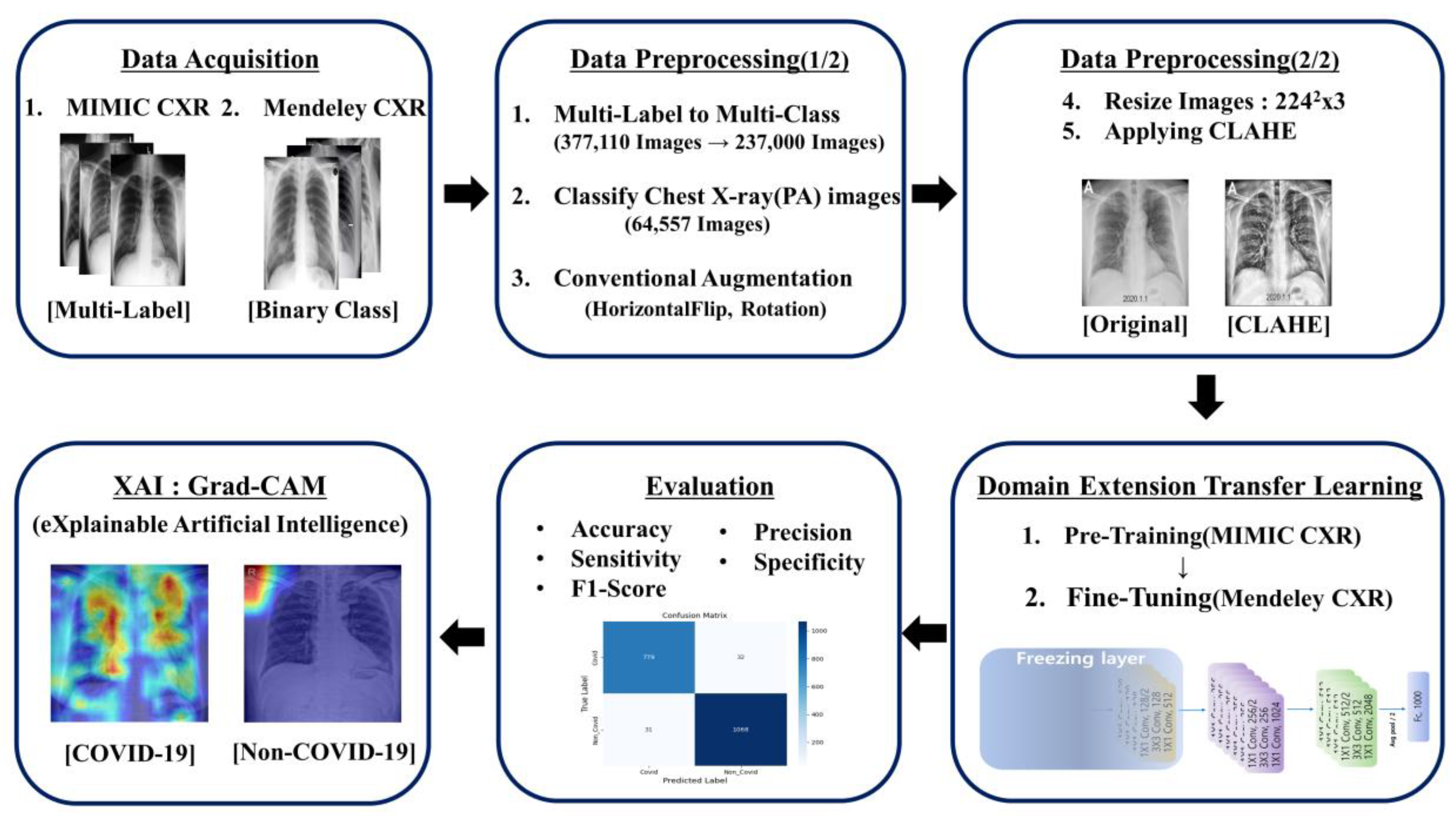
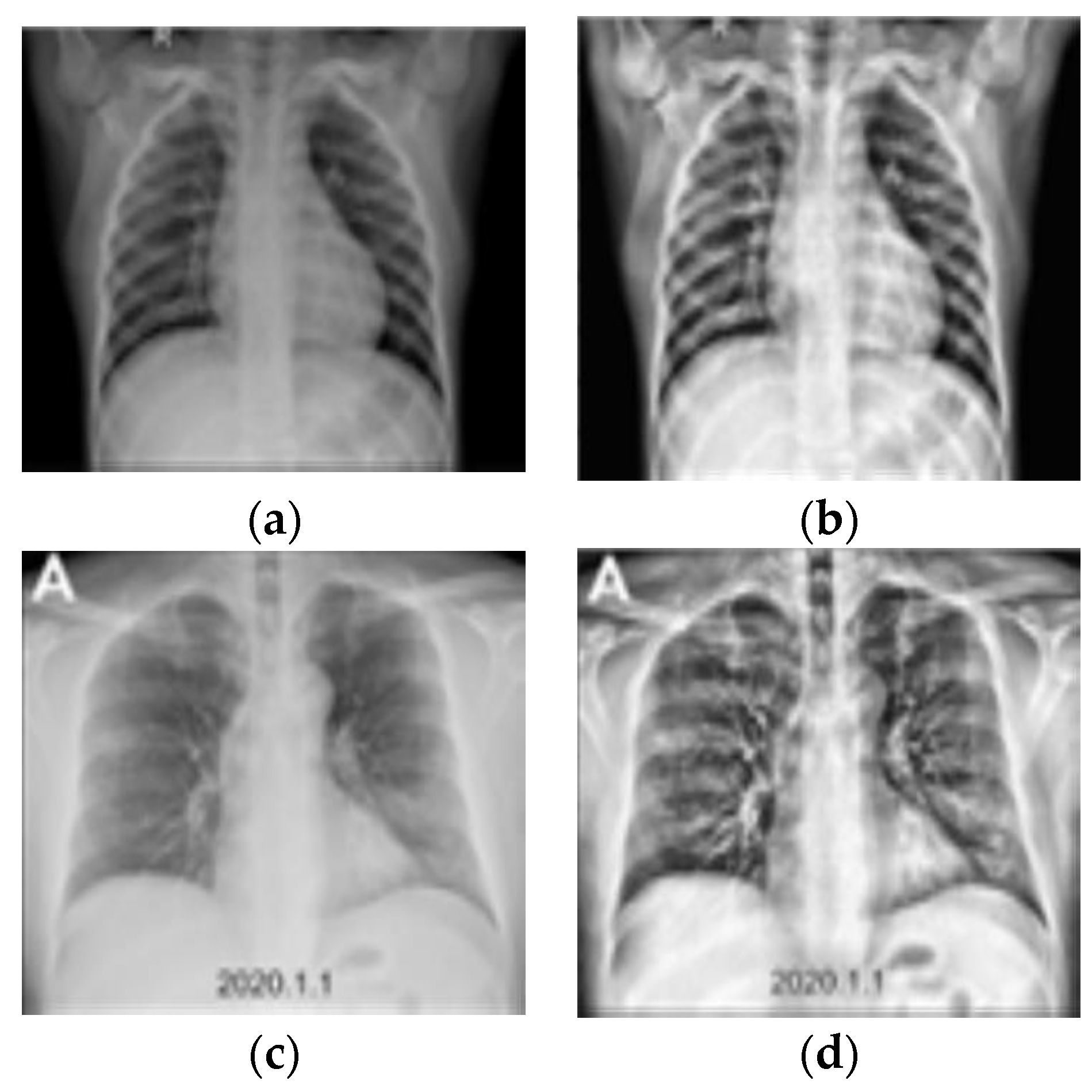




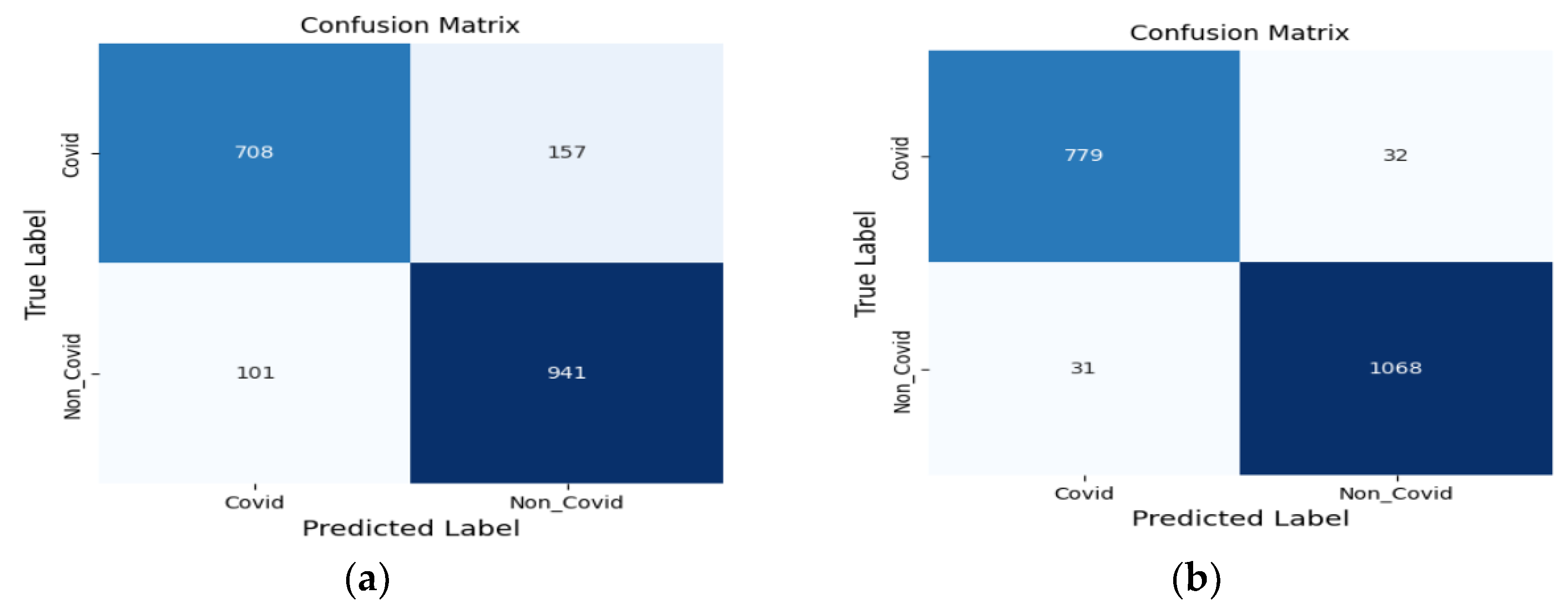

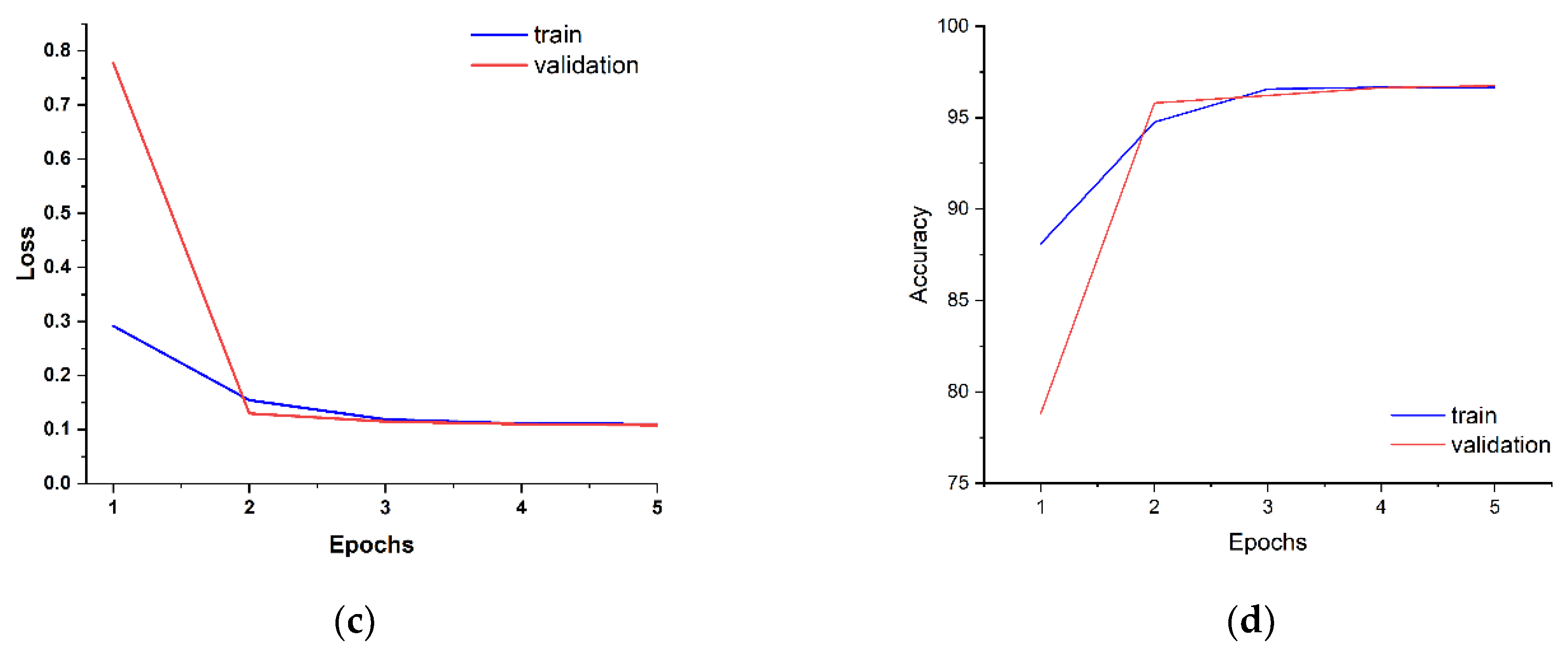
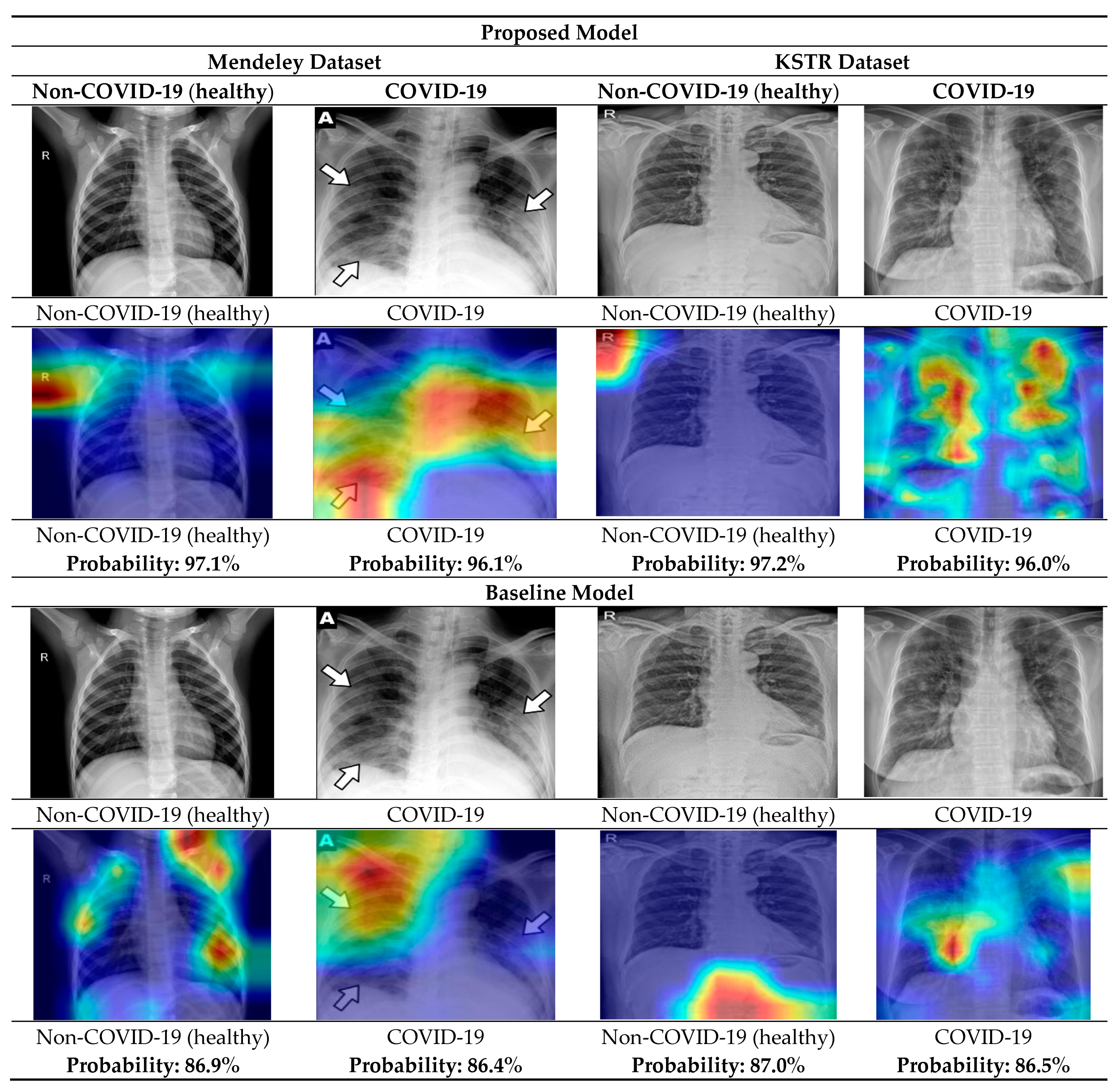
| Mendeley Dataset | Training | Validation | Testing | |
|---|---|---|---|---|
| Class | Images | |||
| COVID-19 | 4044 | 2426 | 809 | 809 |
| Non-COVID-19 | 5500 | 3300 | 1100 | 1100 |
| Total | 9544 | 5726 | 1909 | 1909 |
| MIMIC CXR(PA) Dataset | Training | Validation | Testing | |
|---|---|---|---|---|
| Class | Images | |||
| Atelectasis | 2105 | 1684 | 211 | 211 |
| Cardiomegaly | 3106 | 2484 | 312 | 312 |
| Consolidation | 285 | 228 | 28 | 28 |
| Edema | 587 | 469 | 58 | 58 |
| Fracture | 643 | 514 | 64 | 64 |
| Lung Lesion | 810 | 648 | 81 | 81 |
| Lung Opacity | 4113 | 3290 | 416 | 416 |
| No Finding | 48,577 | 38,861 | 4857 | 4857 |
| Pleural Effusion | 2177 | 1741 | 217 | 217 |
| Pneumonia | 1676 | 1340 | 167 | 167 |
| Pneumothorax | 478 | 382 | 47 | 47 |
| Total | 64,557 | 51,641 | 6458 | 6458 |
| CLAHE | ||||
|---|---|---|---|---|
| COVID-19 X-ray | Before | After | Improvement | |
| Resized | SNR | 3.9 DN | 4.6 DN | 0.7 DN |
| SNR (dB) | 1.9 dB | 2.2 dB | 0.3 dB | |
| Models | Accuracy | Precision | Sensitivity | Specificity | F1-Score | Inference Time (MS) | MADDs(G) | Prams |
|---|---|---|---|---|---|---|---|---|
| ResNet-50 | 96.7% | 96.2% | 96.1% | 97.2% | 96.1% | 45 | 4.08 | 23.5 M |
| VGG16 | 95.8% | 95.2% | 94.9% | 96.5% | 95.1% | 225 | 15.46 | 134 M |
| DenseNet-121 | 95.6% | 93.5% | 96.2% | 95.0% | 94.8% | 28 | 2.80 | 7.9 M |
| Inception-V3 | 95.9% | 94.8% | 95.6% | 96.1% | 95.2% | 35 | 2.80 | 21 M |
| MobileNetV2 | 95.5% | 94.3% | 95.1% | 95.8% | 94.7% | 82 | 0.3 | 3.5 M |
| EfficientNet-B0 | 96.3% | 95.4% | 95.9% | 96.6% | 95.6% | 47 | 0.385 | 5.2 M |
| Configurations | Pretraining | Fine-Tuning |
|---|---|---|
| Input Size | 2242 | 2242 |
| Optimizer | AdamW | |
| Learning Rate | 1 × 10−2 | 1 × 10−5 |
| Weight Decay | 0.05 | 1 × 10−8 |
| Optimizer Momentum | , 0.9, 0.999 | |
| Batch Size | 256 | |
| Training Epochs | 100 | 20 |
| Learning Rate Schedule | Cosine Decay | |
| Warm-up Epochs | 10 | N/A |
| Warm-up Schedule | Linear | N/A |
| CLAHE | Clip Limit = 8, Grid Size = 15 | |
| Predicted Class | ||||
|---|---|---|---|---|
| COVID-19 | Non-COVID-19 | Total | ||
| Actual Class | COVID-19 | |||
| Non-COVID-19 | ||||
| Total | ||||
| Models | Accuracy | Precision | Sensitivity | Specificity | F1-Score | MCC | Balanced Accuracy |
|---|---|---|---|---|---|---|---|
| Baseline Model | 86.8% () | 83.1% () | 86.5% () | 87.0% () | 84.2% () | 73.4% () | 86.7% () |
| Proposed Model | 96.7% () | 96.2% () | 96.1% () | 97.2% () | 96.1% () | 93.2% () | 96.6% () |
| Improvement Ratio | 9.9% | 13.1% | 9.6% | 10.2% | 11.9% | 20% | 9.9% |
| Models | Accuracy | Precision | Sensitivity | Specificity | F1-Score | MCC | Balanced Accuracy |
|---|---|---|---|---|---|---|---|
| Baseline (Non-pretrained/Mendeley) | 86.8% () | 83.1% () | 86.5% () | 87.0% () | 84.2% () | 73.4% () | 86.7% () |
| Proposed (Pretrained/MIMIC(PA)—Mendeley) | 96.7% () | 96.2% () | 96.1% () | 97.2% () | 96.1% () | 93.2% () | 96.6% () |
| Model 1 (Pretrained/Mendeley) | 95.8% () | 94.8% () | 95.4% () | 96.1% () | 95.1% () | 91.3% () | 95.8% () |
| Model 2 (Non-pretrained/MIMIC–Mendeley) | 95.6% () | 94.4% () | 95.3% () | 95.9% () | 94.8% () | 90.1% () | 95.6% () |
| Model 3 (Non-pretrained/MIMIC(PA)–Mendeley) | 95.6% () | 94.5% () | 95.0% () | 96.0% () | 94.8% () | 90.1% () | 95.5% () |
| Model 4 (Pretrained/MIMIC–Mendeley) | 95.9% () | 95.8% () | 94.5% () | 97.0% () | 95.2% () | 91.2% () | 95.7% () |
| Author | Dataset | DL Model | All Data | COVID Data | Train All/COVID | Validation All/COVID | Test All/COVID | Sensitivity | Specificity |
|---|---|---|---|---|---|---|---|---|---|
| Proposed | COVID-19 and non-COVID-19 | ResNet-50 | 74, 101 (MIMIC and Mendeley) | 5500 | 54,941/2426 | 7558/809 | 7558/809 | 96.1% | 97.2% |
| [19] | ResNet-50 | 9545 (Mendeley) | 5500 | 7636/4400 | -/- | 1909/1100 | 97.7% | 94.9% | |
| [20] | Dark-CovidNet | 627 | 127 | 400/101 | 100/26 | -/- | 95.1% | 95.3% | |
| [24] | CovidXNet | 610 | 305 | 244/244 | 61/61 | -/- | 97.8% | 94.7% | |
| [18] | RadiomiX | 1381 | 181 | 1104/145 | -/- | 276/36 | 78.9% | 91.0% | |
| [46] | DenseNet-121 | 2724 | 1029 | 1059/526 | 328/177 | 1337/326 | 84.0% | 93.0% | |
| [47] | Inception-ResNet-v2 | 905 | 419 | 534/242 | 92/43 | 279/134 | 82.8% | 84.3% | |
| [48] | U-Net | 5212 | 275 | 3285/657 | 597/120 | 1330/266 | 96.3% | 93.6% |
| t-Test | ||
|---|---|---|
| Hypothesis | p-Value | 95% c. i |
| p < 0.05 | [9.879, 9.898] [8.962, 8.981] [8.816, 8.835] [8.809, 8.828] [9.132, 9.151] | |
Publisher’s Note: MDPI stays neutral with regard to jurisdictional claims in published maps and institutional affiliations. |
© 2022 by the authors. Licensee MDPI, Basel, Switzerland. This article is an open access article distributed under the terms and conditions of the Creative Commons Attribution (CC BY) license (https://creativecommons.org/licenses/by/4.0/).
Share and Cite
Park, K.; Choi, Y.; Lee, H. COVID-19 CXR Classification: Applying Domain Extension Transfer Learning and Deep Learning. Appl. Sci. 2022, 12, 10715. https://doi.org/10.3390/app122110715
Park K, Choi Y, Lee H. COVID-19 CXR Classification: Applying Domain Extension Transfer Learning and Deep Learning. Applied Sciences. 2022; 12(21):10715. https://doi.org/10.3390/app122110715
Chicago/Turabian StylePark, KwangJin, YoungJin Choi, and HongChul Lee. 2022. "COVID-19 CXR Classification: Applying Domain Extension Transfer Learning and Deep Learning" Applied Sciences 12, no. 21: 10715. https://doi.org/10.3390/app122110715
APA StylePark, K., Choi, Y., & Lee, H. (2022). COVID-19 CXR Classification: Applying Domain Extension Transfer Learning and Deep Learning. Applied Sciences, 12(21), 10715. https://doi.org/10.3390/app122110715







